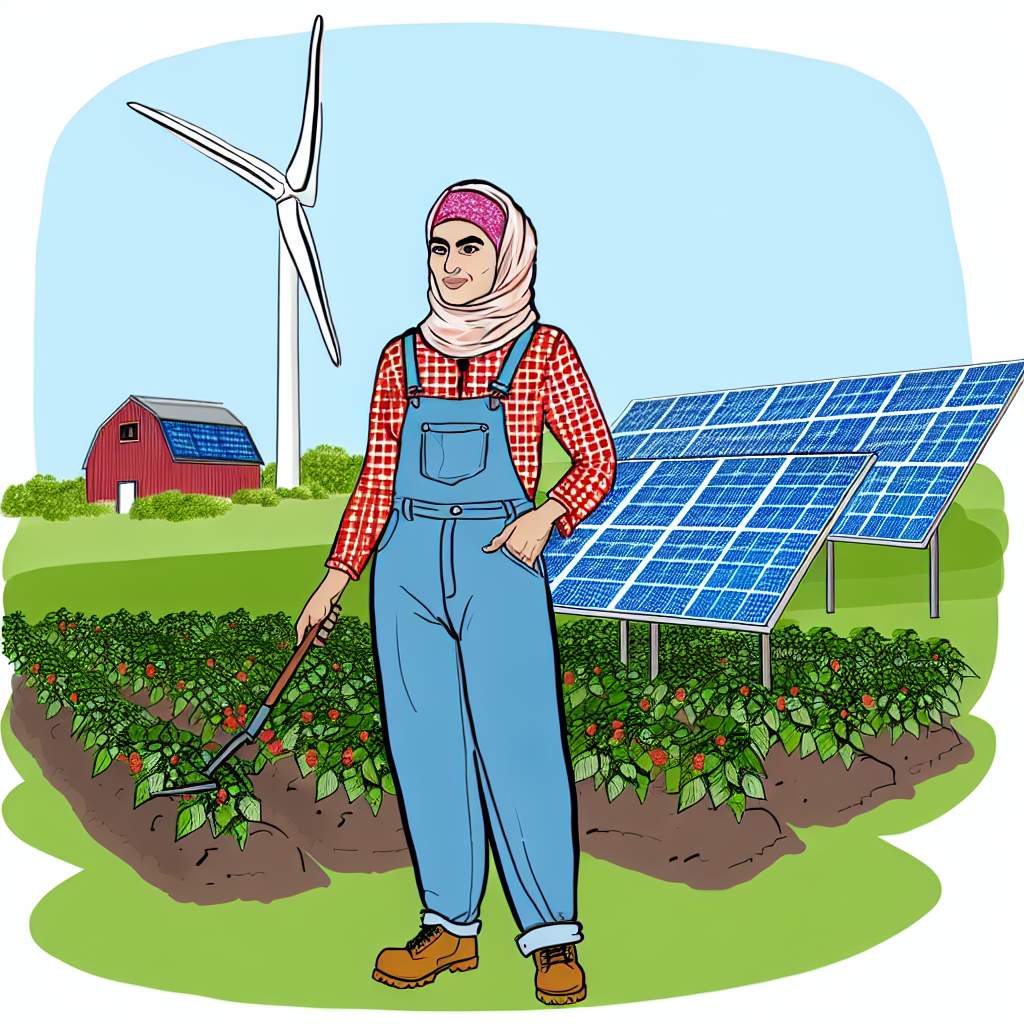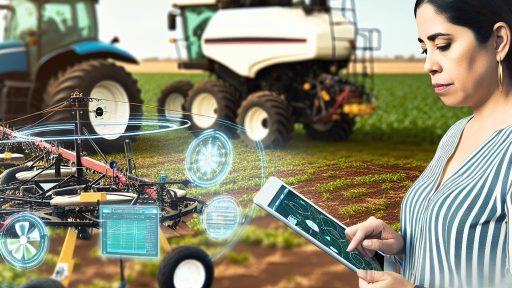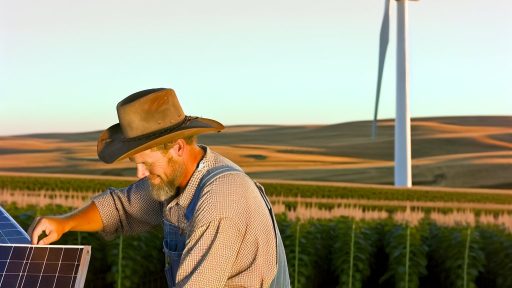Introduction to Renewable Energy and its Importance for Farms
Renewable energy plays a vital role in modern agriculture.
It helps farmers reduce reliance on fossil fuels.
This transition supports sustainable farming practices.
In addition, renewable energy can lower operating costs.
Various renewable options are available for diversified farms.
Types of Renewable Energy Solutions
Solar energy is one of the most popular choices.
Farmers can install solar panels on rooftops or fields.
Wind energy is another effective solution.
Wind turbines can generate electricity in open areas.
Biomass energy utilizes organic materials for power generation.
This option often makes use of farm waste products.
Benefits for Diversified Farming Operations
Using renewable energy enhances operational efficiency.
It can provide stable energy solutions year-round.
This stability improves productivity across various farm enterprises.
Moreover, renewable energy systems can increase farm resilience.
Transform Your Agribusiness
Unlock your farm's potential with expert advice tailored to your needs. Get actionable steps that drive real results.
Get StartedThey reduce costs associated with energy supply disruptions.
Reducing Environmental Impact
Renewable energy significantly lowers greenhouse gas emissions.
This shift contributes to climate change mitigation.
Additionally, it promotes cleaner air and water quality.
Farmers adopting these solutions can enhance their public image.
They demonstrate commitment to environmental stewardship.
Implementation Challenges and Solutions
Transitioning to renewable energy comes with challenges.
Initial costs for equipment and installation can be high.
Nonetheless, various financing options exist for farmers.
Government incentives also help ease financial burdens.
Collaboration with energy consultants can guide implementation.
Overview of Different Renewable Energy Sources
Solar Energy
Solar energy harnesses sunlight to generate electricity or heat.
It uses photovoltaic cells to convert light into power.
Farmers can install solar panels on rooftops or open land.
This solution reduces utility costs and environmental impacts.
Moreover, it provides energy independence to farms.
Wind Energy
Wind energy utilizes wind turbines to produce electricity.
These turbines convert kinetic energy from wind into usable power.
Landowners can benefit by leasing land for wind farms.
Wind energy is clean and renewable, reducing carbon footprints.
Additionally, it can provide a steady income stream for farmers.
Biomass
Biomass energy derives from organic materials like crops and livestock waste.
This solution converts waste into electricity or biofuels.
Utilizing biomass helps manage waste on diversified farms.
Showcase Your Farming Business
Publish your professional farming services profile on our blog for a one-time fee of $200 and reach a dedicated audience of farmers and agribusiness owners.
Publish Your ProfileFurthermore, it offers a sustainable alternative to fossil fuels.
It can also improve soil health by returning nutrients to the land.
Hydro Energy
Hydro energy captures the power of flowing water to generate electricity.
This method is effective when farms are near water sources.
Small hydropower systems can suit diversified farms well.
Moreover, hydro energy is reliable and efficient over time.
It contributes to a diversified energy portfolio for farmers.
Benefits of Implementing Renewable Energy Solutions on Diversified Farms
Cost Savings
Renewable energy solutions significantly reduce operational costs.
By harnessing solar or wind power, farms can lower energy bills.
This shift mitigates the impact of fluctuating fossil fuel prices.
Over time, the investment in renewable technologies pays off.
Environmental Impact
Utilizing renewable energy reduces greenhouse gas emissions.
This transition helps combat climate change effectively.
Farms employing these solutions contribute to a cleaner environment.
They also promote biodiversity and improve ecosystem health.
Energy Independence
Renewable energy fosters energy independence for farms.
By generating their own power, farmers rely less on external sources.
This self-sufficiency enhances resilience against energy shortages.
Moreover, it stabilizes energy costs over the long term.
Attracting New Customers
Consumers increasingly prefer environmentally friendly products.
Farms that adopt renewable energy attract eco-conscious customers.
This shift can enhance brand loyalty and market reach.
Showcasing sustainability can provide a competitive edge.
Government Incentives
Various programs support the integration of renewable energy.
Many governments offer tax incentives and grants for installations.
These financial breaks reduce the initial capital needed.
Thus, farmers can transition more easily to sustainable practices.
Long-Term Sustainability
Renewable energy contributes to the farm’s long-term viability.
It reduces reliance on exhaustible resources.
Furthermore, sustainable practices promote soil and water conservation.
Investing in renewable solutions ensures future productivity and health.
You Might Also Like: Eco-Friendly Pest Management Strategies for Sustainable Farms
Case Studies: Successful Renewable Energy Integration in Diverse Agricultural Settings
Energy Integration at Maple Grove Farm
Maple Grove Farm successfully integrated solar panels into their operations.
Their panels now supply over 80% of their annual energy needs.
This transition reduced their energy costs significantly.
Consequently, the farm could invest more in sustainable practices.
They also experienced a decrease in their carbon footprint.
Diversity in Energy Sources at Green Valley Orchards
Green Valley Orchards adopted a multifaceted approach to energy use.
They combined wind turbines and geothermal heating systems.
This strategy enhances their energy resilience throughout the year.
Showcase Your Farming Business
Publish your professional farming services profile on our blog for a one-time fee of $200 and reach a dedicated audience of farmers and agribusiness owners.
Publish Your ProfileThe farm now generates 60% of their energy needs on-site.
Moreover, this diversified energy mix improves their sustainability profile.
Community Impact through Renewable Energy at Sunny Meadows Farm
Sunny Meadows Farm launched a community solar project.
This initiative allowed local families to benefit from solar energy.
As a result, the farm turned into a community energy hub.
The project increased public awareness of renewable options.
Additionally, it fostered community engagement in sustainability efforts.
Lessons from the Prairie Winds Ranch
Prairie Winds Ranch implemented bioenergy solutions successfully.
They converted agricultural waste into energy through anaerobic digestion.
This process reduces waste while generating electricity.
Moreover, it provided additional income through energy sales.
Farmers benefited from reduced waste management costs.
Next Steps for Renewable Energy Adoption
These case studies highlight the potential of renewable energy.
Diverse farms can thrive by adopting such technologies.
Investing in renewable solutions fosters sustainability and profitability.
Farmers should explore the options that suit their unique needs.
As more farms adopt these practices, the agriculture sector becomes greener.
You Might Also Like: Utilizing Drones For Precision Farming Applications
Challenges and Barriers to Adopting Renewable Energy on Farms
Financial Constraints
Many farmers face significant financial barriers when investing in renewable energy.
Initial costs for solar panels or wind turbines can be daunting.
Additionally, access to funding or grants may be limited.
Farmers often prioritize immediate operational expenses over long-term investments.
Technology Limitations
Not all farms have access to the latest renewable energy technologies.
Some technologies may not be suited for specific farming operations.
Furthermore, the lack of technical expertise can hinder implementation.
Farmers may struggle to integrate new systems with existing operations.
Regulatory Challenges
Navigating the regulatory landscape can be complex for farmers.
Permits and licenses may be required before installing renewable systems.
Compliance with local regulations can slow down the adoption process.
Additionally, changes in policy can create uncertainty for farmers.
Market Barriers
Market acceptance of renewable energy on farms can be slow.
Consumers may not prioritize products from renewable energy sources.
Moreover, forms of renewable energy integration may not be well understood in rural areas.
Cultural Resistance
Cultural perceptions can create resistance to adopting renewable practices.
Some farmers may be hesitant to change traditional farming methods.
Education and community engagement can help shift these perceptions.
Building trust in renewable technologies is essential for wider acceptance.
Find Out More: Diversifying Revenue Streams In Agricultural Enterprises Successfully

Financial Options and Incentives for Farmers Utilizing Renewable Energy Technologies
Understanding Financial Incentives
Farmers can benefit significantly from various financial incentives.
These incentives encourage the adoption of renewable energy solutions.
Showcase Your Farming Business
Publish your professional farming services profile on our blog for a one-time fee of $200 and reach a dedicated audience of farmers and agribusiness owners.
Publish Your ProfileGrants, loans, and tax credits are commonly available options.
Each state has different programs tailored to agricultural needs.
Types of Financial Options
Farmers can explore multiple financial options to fund renewable energy projects.
- Grants help cover initial project costs without repayment obligations.
- Low-interest loans provide affordable financing for larger investments.
- Tax credits reduce tax liabilities, improving overall cash flow.
- Power purchase agreements allow farmers to install systems at little upfront cost.
Federal and State Incentives
Various federal programs support renewable energy adoption in agriculture.
The USDA administers the Rural Energy for America Program, offering grants and loans.
Moreover, the federal investment tax credit provides significant savings for solar installations.
Farmers should also investigate state-specific incentives for renewable energy.
Local Grants and Loans
Many local organizations provide funding opportunities for renewable energy projects.
These grants can cover a portion of equipment costs and installation fees.
Farmers should contact their local agricultural extension office for information.
Additionally, local banks may offer loans with favorable terms for sustainability projects.
Utilizing Utility Incentives
Utilities often provide incentives for renewable energy installations.
Programs include rebates for solar panels and wind turbines.
Some utilities offer net metering, allowing farmers to sell excess energy back.
This can result in reduced electricity costs and new revenue streams.
Tax Benefits and Deductions
Farmers can take advantage of several tax benefits relating to renewable energy.
The section 179 deduction allows immediate expense deduction for certain equipment.
Moreover, businesses may qualify for accelerated depreciation on renewable systems.
These advantages can significantly impact a farm’s overall tax burden.
Long-term Financial Viability
Investing in renewable energy enhances long-term financial viability for farmers.
Reduced energy costs contribute to overall profitability.
Furthermore, sustainable practices can attract environmentally-conscious consumers.
Ultimately, these efforts can increase market opportunities and farm resilience.
Learn More: Overcoming Common Supply Chain Challenges in Farming
Technological Innovations in Renewable Energy Specific to Agriculture
Solar Energy Solutions
Farmers increasingly adopt solar technology to generate electricity.
Solar panels can power irrigation systems, greenhouses, and machinery.
This technology reduces reliance on fossil fuels while cutting energy costs.
Moreover, solar farms can coexist with traditional crops, maximizing land use.
Wind Energy Applications
Wind turbines offer a viable energy source for diversified farms.
Farmers can sell excess electricity back to the grid, generating income.
Additionally, wind energy complements other renewable sources effectively.
It provides significant savings on energy bills and promotes sustainability.
Biogas Production
Biogas technology transforms farm waste into renewable energy.
This process reduces waste while producing biogas for heating and electricity.
Farmers can utilize anaerobic digesters to enhance energy efficiency.
Furthermore, biogas systems promote soil health through nutrient-rich byproducts.
Geothermal Heating Systems
Geothermal energy offers an innovative heating source for farms.
These systems utilize the Earth’s stable temperature to provide efficient heating.
They can significantly reduce heating costs in greenhouses and livestock facilities.
Moreover, geothermal systems have a low environmental impact.
Showcase Your Farming Business
Publish your professional farming services profile on our blog for a one-time fee of $200 and reach a dedicated audience of farmers and agribusiness owners.
Publish Your ProfileSmart Farming Technologies
Integrating smart technologies increases energy efficiency on farms.
Farmers use sensors and automation to optimize energy consumption.
This approach enhances productivity and sustainability in agricultural practices.
Data analytics help farmers make informed decisions regarding energy usage.
Energy Storage Solutions
Advanced battery systems store excess energy for later use.
These solutions enable farmers to manage energy availability effectively.
This capability minimizes downtime during peak energy demand periods.
Consequently, energy storage enhances the overall resilience of farming operations.
Future Trends: The Role of Smart Technology and Energy Storage in Sustainable Farming
Integration of Smart Technology
Smart technology transforms the agricultural landscape effectively.
This advanced tech allows for automation and improved efficiency.
Farmers can access data-driven insights in real-time.
Consequently, they make informed decisions on resource management.
Examples of smart technology include precision agriculture tools.
These tools utilize sensors, drones, and satellite imagery.
Thus, they help monitor crop health and soil conditions.
Benefits of Energy Storage
Energy storage systems enhance the reliability of renewable energy sources.
Batteries and other storage technologies hold excess energy produced by farms.
Farmers can then utilize this stored energy during peak usage times.
This process reduces reliance on the grid and cuts costs significantly.
Furthermore, energy storage stabilizes energy supply for ongoing operations.
Enhancing Sustainability Practices
Integrating smart technology also promotes sustainability in farming.
Farmers can optimize water usage and minimize waste effectively.
Smart irrigation systems detect moisture levels and adjust automatically.
As a result, they conserve resources without compromising crop yield.
Similarly, energy-efficient equipment reduces overall energy consumption.
Future Prospects
The combined use of smart technology and energy storage promises significant advancements.
Farms will increasingly rely on renewable energy and automation.
Farmers will benefit from lower operational costs and enhanced productivity.
Moreover, these innovations will help combat climate change impacts directly.
Thus, sustainable farming practices will become more widespread.
Additional Resources
USDA Science and Research Strategy, 2023-2026: Cultivating …
Natural Resources and Sustainable Agricultural Systems : USDA ARS




